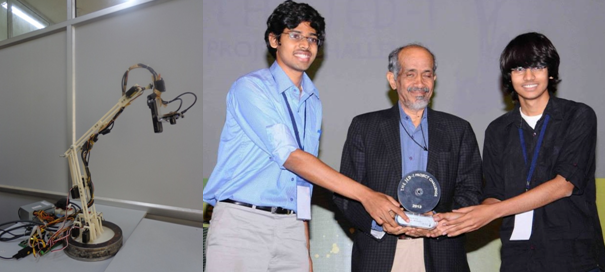Project-Junior wins laurels at IISc, IIM, 19 June
In sync with IIT Mandi’s vision to produce professionals capable of leading efforts towards innovative products and processes, students have, yet again, won prestigious laurels for their innovative product—the robotic arm designed under the Project-Junior
The Project-Junior is the name given to a new form of augmented reality (AR) interface developed for the computing devices by IIT Mandi students. The basic idea behind the project was to provide user with better means of interacting with the computers.
The students’ brainchild bagged the second place under mechanical division at Jed-i (Joy of Engineering, Design and Innovation) project challenge, Indian Institute of Science (IISc) Bangalore, competing against 69 teams from all over India on June 14, 2013. The Jed-i project challenge is an annual event designed to identify and showcase the best final year engineering project. “The compact robotic arm designed by us as part of our final-year B.Tech project received great appreciation from the judges and top technocrats of the country,” the winning team said. The project was also selected among the top 10 projects at Next Big Idea at IIM Bangalore and top rated for its potential to hit the markets in the near future.
Junior, the robotic arm, resembles a table lamp. Gestures beneath the lamp and touch on the projected screen on the surface of the table are the main means of giving input to the device. Junior is completely automated. The body of Junior can orient the projector screen in any manner the user specifies, thus breaking free from the physical limitations of the traditional screen. Using gestures and touch would mean that the interaction with the machine is more natural and intuitive. An added advantage of the projector system is that the digital information can now be blended with the physical environment and objects. At present, Junior (the robotic arm) can accept four gestures, two for zooming in and out, one for object augmentation and one for stand-by. When a user places an object in front of the robot, it captures the images of the object and based on image search, finds relevant information about the object and projects it on the table beside the object.
The device was designed in CAD and then was printed using 3-D printer at IIT Mandi’s Mechanical workshop. The camera mounted on the head of the lamp recognizes the gesture made by the user and projects the appropriate information at the desired spot on the table. The image and video processing required for the above function is carried out on a computer that is integrated to the camera-projector setup. The desired information is obtained by a scripting program that runs on the computer. The computer then sends the control signals to both the projector (as to what information to display) and the robotic arm controller (as to where to move and project).
Its potential applications are in R&D labs, hospitals and medical centers of research and learning, academic institutions, libraries and classrooms for enhanced learning, offices (as a replacement for the traditional computer peripherals), malls and showrooms for advertisements and blending digital information with the physical products, homes for enhanced user interaction with computing devices.
The students’ team consists of Akshay J. Kulkarni (Electrical Engineering), Anurag Jakhotia (Mechanical Engineering), Chinmay D. Bhagat (Electrical Engineering), Kanhaiya Mishra (Electrical Engineering), Nikki Kumar (Electrical Engineering), Shyam Sundar (Mechanical Engineering), Vignesh Venkateshwaran (Electrical Engineering).
The students worked on the project under the guidance of Dr. Anil Sao (School of Computing and Electrical Engineering, IIT Mandi) and Dr. Om Prakash Singh (School of Engineering, IIT Mandi).
 |
| The robotic arm (Junior) designed by IIT Mandi students. Right: IIT Mandi students receiving award at IISc. |